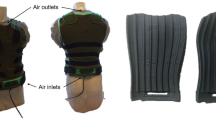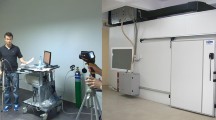Abstract
Ten healthy young men participated in two series of three trials: series 1 (C1) with, or without, local restriction of evaporation (either on the trunk or on the legs) and series 2 (C2) with, or without, local moderate nitrogen ventilation (40 l · min−1) under an impermeable garment (trunk or leg ventilation). After 60-min rest in a thermoneutral environment, the subjects exercised in a warm environment [30°C, 47% relative humidity (rh) during Cl and 29% rh during C2] on a cycle ergometer for 60 min at 70 W during C1 or at 60 W during C2. During C1, local covering with plastic foil did not increase internal temperature, but increased the mean skin temperature with a higher effect in the case of leg restriction. The trunk skin temperature was affected by the leg covering while the leg skin temperature was not changed by the trunk covering. Only the local sweat rate of the trunk was increased by the two restriction conditions. During C2, internal temperature was decreased by local ventilation while mean skin temperature was reduced only by trunk ventilation. The local ventilation affected only trunk skin temperature with a greater decrease during trunk ventilation. Trunk ventilation did not influence the skin temperature of the legs while ventilation of the legs decreased trunk skin temperature. In addition, leg ventilation decreased the sweat rate of the legs. The impermeable suit worn during C2 led to a greater physiological strain compared to the plastic film worn during C1 even with local ventilation under the impermeable garment. As expected, limiting sweat evaporation led to an increase in physiological strain. Microclimate ventilation at a rate of 40 l · min−1 was not sufficient to allow total heat dissipation but allowed 60-min exercise in a warm environment to be completed without excessive heat accumulation. It would appear that ventilation of the trunk locally was the best solution because of the smaller increase in skin temperature and higher sweating capacity of the trunk.
Similar content being viewed by others
References
Banta GR, Braun DE (1992) Heat strain during at-sea helicopter operations and the effect of passive microclimate cooling. Aviat Space Environ Med 63:881–885
Cadarette BS, Barry MS, DeCristofano BS, Speckman KL, Sawka MN (1990) Evaluation of three commercial microclimate cooling systems. Aviat Space Environ Med 61:71–76
Fonseca G (1976) Effectiveness of four water-cooled undergarments and a water-cooled cap in reducing heat stress. Aviat Space Environ Med 47:1159–1164
Garwood DR (1988) Air-sources, supply and cooling. Ergonomics 31:1015–1023
Hardy JD, DuBois EF (1938) Basal metabolism, radiation, convection and evaporation at temperatures of 22–35°C. J Nutr 15:477–496
Lejeune D, Loncle M, Kerguelen M, Beaumont M (1991) Limitation de la contrainte thermique liée au port de la combinaison NBC par ventilation individuelle. Med Aeronaut Spat 30:422–427
Montain SJ, Sawka MN, Cadarette BS, Quigley MD, McKay JM (1994) Physiological tolerance to uncompensable heat stress: effects of exercise intensity, protective clothing, and climate. J Appl Physiol 77:216–222
McLellan TM (1993) Work performance at 40°C with Canadian forces biological and chemical protective clothing. Aviat Space Environ Med 64:1094–1100
McLellan TM, Jacobs I, Bain JB (1993) Influences of temperature and metabolic rate on work performance with Canadian Forces NBC Clothing. Aviat Space Environ Med 64:587–594
Nunneley SA, Reader DC, Maldonado RJ (1982) Head-temperature effects on physiology, comfort, and performance during hyperthermia. Aviat Space Environ Med 53:623–628
Shapiro Y, Pandolf KB, Sawka MN, Toner MM, Winsmann FR, Goldman RF (1982) Auxiliary cooling: comparison of air-cooled versus water-cooled vests in hot-dry and hot-wet environments. Aviat Space Environ Med 53:785–789
Shitzer A, Chato JC, Hertig BA (1971) Thermal protective garment using independent regional control of coolant temperature. Aerosp Med 1:49–59
Shvartz E (1972) Efficiency and effectiveness of different water cooled suits — a review. Aerosp Med 43:488–491
Shvartz E, Aldjem M, Ben-Mordechai J, Shapiro Y (1974) Objective approach to a design of a whole-body, water-cooled suit. Aerosp Med 45:711–715
Speckman KL, Allan AE, Sawka MN, Young AJ, Muza SR,Pandolf KB (1988) Perspectives in microclimate cooling involving protective clothing in hot environments. Int J Ind Ergon 3:121–147
Tamura T, Young An M (1993) Physiological and psychological thermal response to local cooling of human body. J Therm Biol 18:335–339
Van de Linde EJG, Lotens WA (1983) Sweat cooling in impermeable clothing. In: Aspects médicaux et biophysiques des vêtements de protection. ed. by Centre de Recherches du Service de Santé des Armées, pp 260–267
Young AJ, Sawka MN, Epstein Y, DeCristofano BS, Pandolf KB (1987) Cooling different body surfaces during upper and lower body exercise. J Appl Physiol 63:1218–1223
Author information
Authors and Affiliations
Rights and permissions
About this article
Cite this article
Desruelle, A.V., Bothorel, B., Hoeft, A. et al. Effects of local restriction of evaporation and moderate local ventilation on thermoregulatory responses in exercising humans. Europ. J. Appl. Physiol. 73, 231–236 (1996). https://doi.org/10.1007/BF02425481
Accepted:
Issue Date:
DOI: https://doi.org/10.1007/BF02425481




